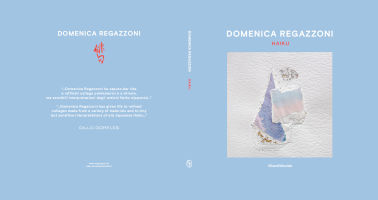
Imagine the sky on a sunny day in which the yellow and blue attain a maximum splendour. Or a transparent sea so calm that the naked eye can plumb the depths and see the seabed. Beauty and perfection.
Domenica Regazzoni’s haiku declare that beauty exists but is not perfect, fortunately for us. And they tell of light but tangible moments of grace in which, behind the curtain of things and the visible lives a world of grace and colour, of elegance and memory, of living dust that embraces our history and absolves all melancholy. A world that is sometimes mottled and impervious, but which is, after all, ours: it is viscerally ours, it is before our eyes. It is sufficient to dig a little, even if few people do so because it takes time and offers no special offers, makes no handsome promises. It does not even ask about us or judge us. You do not need a pass: you just need to rid yourself of the ballast of everyday life and abandon yourself to Timeless Time, and with a wandering spirit, venture into these minimal but dense geographies, going in and out and from one to the other, taking something with you every time.
Domenica Regazzoni is a poetic artist. This means that she translates into artistic form those visions that poets translate into verses and words.
“Ut pictura poesis”, wrote Quintus Horatius Flaccus (Horace) in his Ars Poetica. “As is painting, so is poetry”. Over the centuries, there has been much discussion on this subject, from Horace himself to Leonardo, to the Academy; in 1547 Benedetto Varchi held a “Lezzione” at the Florentine Academy on the similarities and differences between painters and poets and how the time of perception of a painting and a poem were dissimilar.
In his Treatise of Painting Leonardo notes: “Now you see what a difference it is to hear of a thing that gives pleasure to the eye over time, or to see it with that promptness with which one sees natural things. And even though the things of poets are read over a long interval of time, there are often times when they are not understood [...] whereas the immediate work of the painter is understood by his viewers”.
But in reality Leonardo did not know the Japanese composition of three lines (nor could he, since the haiku was born after his death), which contracts time and tends to the immediacy of perception in like manner to the attribution Leonardo gives to painting.
Domenica Regazzoni’s precious haiku take up the impalpable sense of nature, of the flowing seasons of which they evoke a instant removed from Time, which are the simple and complex heart of the Japanese poetic compositions.